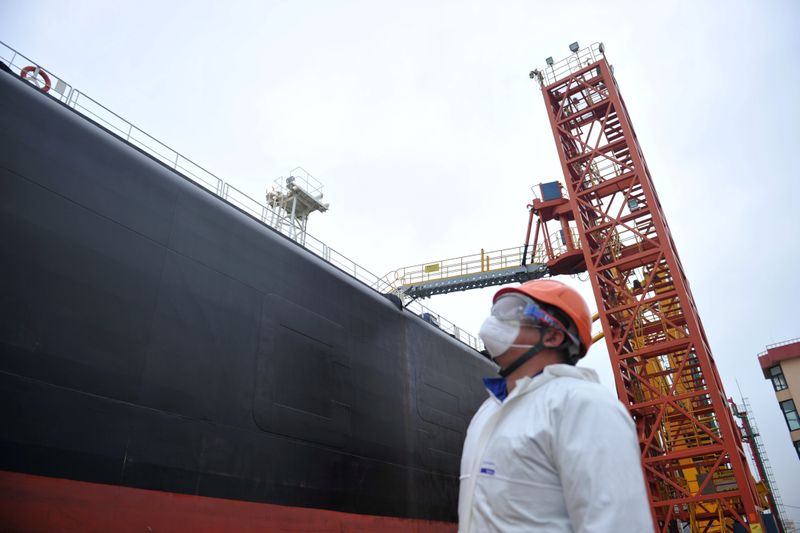BEIJING (Reuters) – Congestion at China’s east coast oil ports that is adding to costs for shippers and importers is likely to run well into August, with crude shipments set to hit another record high this month, according to analysts and Refinitiv data.
The massive inflows are straining offloading facilities, while refiners and port operators in Shandong province — home to a quarter of China’s refining capacity — are rushing to build new storage tanks.
July seaborne arrivals into the world’s biggest oil importer are expected to surge to 14.4 million barrels per day, Refinitiv analyst Emma Li said, well above record imports of 12.9 million bpd in June.
China waded into oil markets in April when prices collapsed to multi-decade lows, snapping up cargoes for delivery in coming months.
(Graphic: Qingdao anchorage vessel congestion – https://fingfx.thomsonreuters.com/gfx/ce/qmypmknjjpr/QingdaoAnchorageCongestion.png)
As of July 23, about 120 million barrels of crude were waiting off Chinese ports to discharge, up from around 80 million barrels in early July, Refinitiv data showed.
Commercial crude inventories had already grown to 1.12 billion barrels by end-June, said SIA Energy analyst Seng Yick Tee, enough oil to operate China’s refineries at 2019 utilization levels for nearly three months.
REFINER SLOWDOWN
Even as imports are rising, refiners are starting to trim crude processing rates. Analysts say fuel demand has stalled, pushing up stockpiles of oil products, while refiner margins have fallen on higher oil prices.
The average utilization rate at independent refiners in Shandong fell to about 74% this week from a record high of 76% last month, said Li Yan, analyst at China-based Longzhong Information consultancy.
Port officials and analysts estimate the pile-up could extend well into August or even into September if traders transfer oil stored on floating tankers to onshore facilities.
It could take up to two months to fully discharge floating storage of about 70-80 million barrels, said FGE analyst Jiyao Chen.
Independent refineries have already significantly scaled back crude purchases for August and September deliveries, noted IHS Markit analyst Xiaonan Feng.
(Graphic: China’s East Coast ports suffer severe congestion as big oil imports arrive – https://fingfx.thomsonreuters.com/gfx/ce/gjnvwxywkpw/ChinaOilPortCongestion.png)
An official at Zhoushan port, a major oil hub in eastern China, doubted that port congestion would ease by the end of August.
“It will all depend on turnover rates at terminal and storage tanks, but it’s just so hard to find available storage space,” he said.
Refinitiv’s Li estimates the average waiting time for discharge is 3-4 weeks for vessels in the Qingdao-Rizhao area and around 2 weeks in Ningbo-Zhoushan and other major ports, against normal discharge times of around a week.
NEW STORAGE TANKS
At least nine crude oil storage projects are planned in Shandong province at Qingdao, Rizhao, Binzhou and Dongying ports, adding around 13.66 million cubic metres of tank space in 2020, according to Reuters calculations.
That would be roughly equivalent to about 6% of China’s existing commercial storage, according to analyst estimates.
“We are accelerating the construction process of new storage tanks in order to help ease the port congestion as soon as possible,” said an official at Rizhao port.
Sinopec, Asia’s largest refiner, recently added a combined 1.25 million cubic metres of storage space in Zhejiang province and central Henan province.
(Reporting by Muyu Xu and Gavin Maguire; Editing by Florence Tan and Richard Pullin)






















